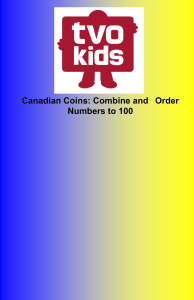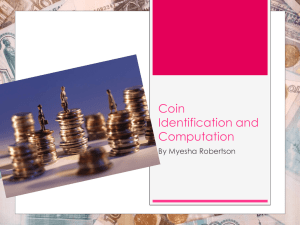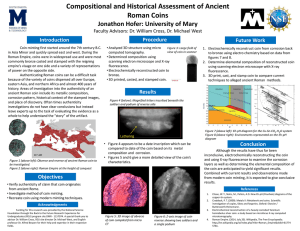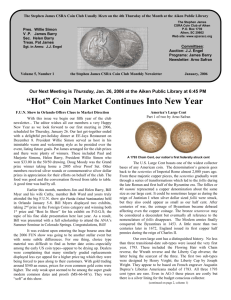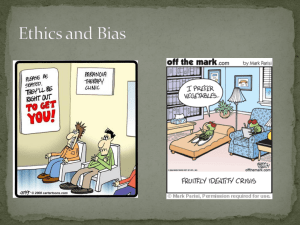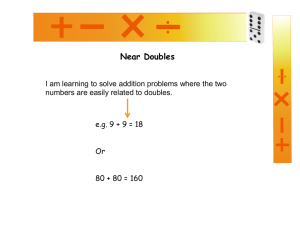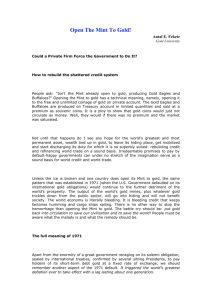Coin Collecting Merit Badge Workshop
advertisement
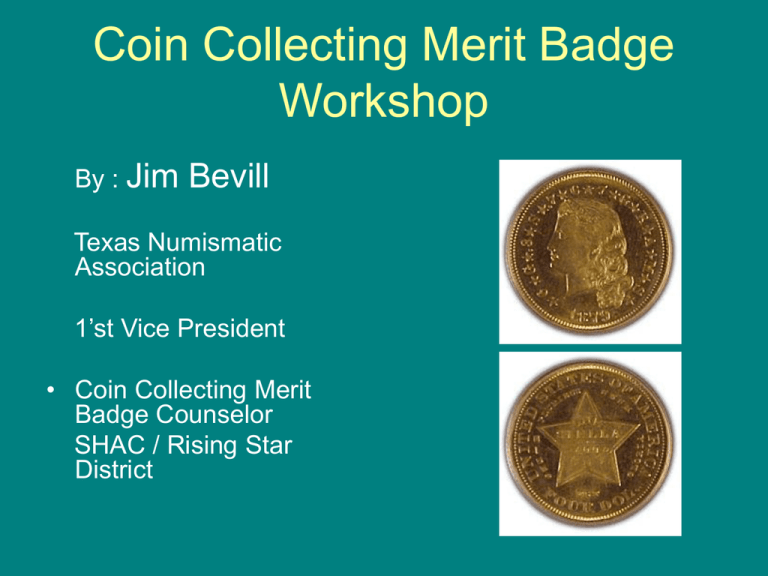
Coin Collecting Merit Badge Workshop By : Jim Bevill Texas Numismatic Association 1’st Vice President • Coin Collecting Merit Badge Counselor SHAC / Rising Star District Merit Badge Requirements • 1) Understand how coins are made, and where the active U.S. Mints are located. This mint opened its doors in 1792 The “Mile High” Mint (as it looked on opening day in 1906) This mint survived the 1906 earthquake and fire ! “The Granite Lady” This mint strikes only gold, silver and platinum bullion coins ! #2 Explain these Collecting Terms • • • • • • A) Obverse B) Reverse C) Reeding D) Clad E) Type Set F) Date Set Obverse = Heads ! Reverse = Tails Many coins have a reeded edge ! Clad coins, are made of fused metal, not gold or silver. Type Set Date Sets – 2 Types • All varieties and mintmarks of a particular date . - or • A series of coins collected in date order, without regard to mintmarks. #3 Coin Grading • Sheldon Grading Scale (see handout) • Grades range from Poor, Good, Fine, Extra Fine, Almost Uncirculated, and Uncirculated on a scale of 1 – 70 ! A coin graded 70 is perfect ! • Very Important ! Very Subjective ! • The higher the grade, the more expensive the coin ! Grading U.S. Mercury Dimes AG Good Fine Mercury Dime Grading Very Fine Extremely Fine Uncirculated Proof Coins • A specially made coin distinguished by sharpness of detail and a brilliant mirrorlike surface. • It is a method of manufacture, double struck with great care on polished dies. • Most proof coins are in perfect, mint state condition, though many older proofs were once in circulation. Is this 1860 Seated Liberty Dollar a proof coin ? Encapsulated or “Slabbed” Coins • Third party guarantee of authenticity. • Independent grading opinion. • Protected in sealed plastic holders. Even the best grading services make mistakes ! #4 Know at least three different ways to store your coin collection ? Know your paper money ! Federal Reserve Notes • The serial number on US paper currency is applied separately from the portraits and symbols that characterize the bill. Printed in bright green ink when the uncut bills arrive at each Reserve Bank, this number represents the bill's unique identity. • A serial number consists of two prefix letters, eight numerals, and a one-letter suffix: • The first letter of the prefix denotes the currency series. • The second letter of the prefix indicates the Federal Reserve Bank at which the bill was produced. • The eight digits represent the bill's sequential order within its group. The one-letter suffix is a further sequential counter within each Reserve Bank's bills in a series. • The suffix letter advances when the 8-digit number reaches 99999999 (for example, xx99999999B is followed by xx00000001C). The entire alphabet is used for this process except for the letter O. • Bills with a star in the place of their suffix letter are replacements for bills that did not meet federal standards after the printing process and are subsequently destroyed. • Bills produced before 1996 were printed with the seal of their particular Reserve Bank; new bills feature a universal Federal Reserve Seal. #5 Identify the people on the $1, $2, $5, $10, $20, $50, $100 …also…Explain “legal tender” Describe the role of the Federal Reserve System plays in the distribution of money. What’s wrong with this $1 bill ? This $2 bill commemorates the American Bicentennial ! What is different about this $5 bill ? Why does this bill say “Hawaii” ? Is something missing on this $20 ? • Some collectors pay big bucks for printing errors on currency ! It can pay you to pay attention to the details on paper money that is in circulation ! $100,000 in Cash ! U.S. Federal Reserve System Federal Reserve is the Banker’s Bank ! #6 Numismatic Reference a) Demonstrate how to use a U.S or a world coin reference catalog. b) Read a numismatic magazine or a newspaper and tell your counselor what you have learned. “The Red Book” (The most widely accepted reference on United States Coins) #7 State Quarters 1) Describe the 19992008 State Quarters Program 2) Collect and show 5 different examples What kind of horse is being ridden on this 1999 Delaware quarter ? #8 Collect from circulation a set of currently circulating U.S. Coins • 1) Include one coin of each denomination. • 2) For each coin, locate the mint marks, if any, and the designers initials. #9 Collect and identify • 1) 50 foreign coins from at least 10 countries. or – • 2) 20 bank notes from at least 5 different countries. – or – 3) 15 different tokens or medals. – or – 4) Collect a date set of a single type since the year of your birth. #10 Do one of the following… • A) Tour a U.S. Mint, BEP, or Federal Reserve bank and describe what you learned. - or • B) Attend a Coin Show or Coin club meeting, or view the mint’s website or a dealer’s website and describe what you’ve learned. - or • C) Give a talk about coin collecting to your troop or at school. - or • D) Do drawings of five Colonial-era U.S. Coins. The Texas Numismatic Association wishes you well on your coin collecting merit badge ! www.TNA.org


